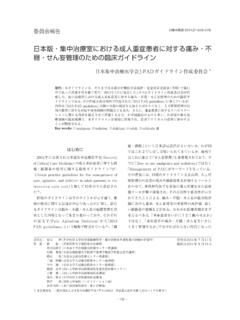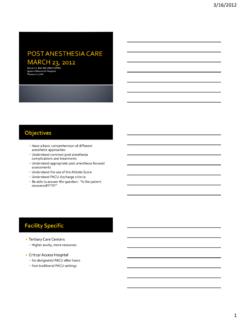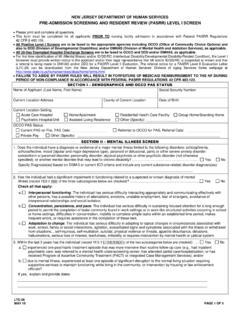Transcription of Serotonin Syndrome - - RN.org®
1 Serotonin Syndrome Reviewed October, 2019, Expires October, 2021 Provider Information and Specifics available on our Website Unauthorized Distribution Prohibited 2019 , , , LLC By Cynthia R. Bascara, APN-C, MSN, CCRN Course Objectives: At the completion of the course, the health care provider will be able to: State the definition and causes of Serotonin Syndrome List the clinical manifestations of Serotonin Syndrome Discuss how Serotonin Syndrome can be diagnosed Discuss the management and prevention of Serotonin Syndrome Discuss some differential diagnoses associated with Serotonin Syndrome Discuss the pediatric considerations of Serotonin Syndrome Definition Serotonin Syndrome is a potentially life-threatening condition manifested by increased serotonergic activity in the central nervous system (CNS) associated with therapeutic medication use such as selective Serotonin reuptake inhibitor (SSRI)
2 , inadvertent interactions between drugs, intentional self-poisoning and increasing the dose of a serotonergic drug in individuals who are particularly sensitive to Serotonin . Serotonin Syndrome is not an idiosyncratic drug reaction but a predictable consequence of excess serotonergic activity at CNS and peripheral Serotonin receptors. For this reason, some experts strongly prefer the terms Serotonin toxicity or Serotonin toxidrome because these more accurately reflect the fact that it is a form of poisoning. Serotonin Syndrome may also be called Serotonin sickness, Serotonin storm, hyperserotonemia, or serotonergic Syndrome . Serotonin Syndrome can be benign or lethal. Epidemiology Serotonin Syndrome can occur in all age groups.
3 There is increased incidence related to increased use of SSRI. In 2004, the Toxic Exposure Surveillance System identified 8,187 moderate or major outcomes out of 48, 204 SSRI exposures and 103 deaths related to Serotonin Syndrome . Around 14 to 16 percent of persons who overdose on SSRIs are thought to develop Serotonin Syndrome . The most widely recognized example of Serotonin Syndrome was the death of Libby Zion in 1984 at age 18. She had an ongoing history of depression and came to a Manhattan hospital with fever, agitation, strange jerky motions of her body. She also seemed disoriented at times. The emergency room physicians were unable to diagnose her condition definitively, but admitted her for hydration and observation.
4 Her death was caused by a combination of pethidine (or meperidine (Demerol) and phenelzine. The physician who prescribed the pethidine was a medical intern. The case had an impact on graduate medical education and residency work hours. Limits were set on working hours for medical post graduates, commonly referred to as interns or residents, in hospital training programs, and there is a new requirement for a closer senior physician supervision. Pharmacology and Cellular Toxicology Serotonin can be found in central nervous system , peripheral nervous system and platelets. In central nervous system, Serotonin modulates attention, behavior, thermoregulation, control of appetite, sleep, memory and learning and depression.)
5 In peripheral nervous system, Serotonin is Involved in regulating GI motility, vasoconstriction, uterine contraction and bronchoconstriction . Serotonin promotes platelet aggregation. Stimulation of the postsynaptic 5-HT1A and 5-HT2A receptors has been implicated in Serotonin Syndrome but no single receptor is solely responsible. Serotonergic drugs/agents CLASS DRUGS Antidepressants MAOIs ( phenelzine-Nardil), SSRIs ( Zoloft, Prozac, Paxil); TCAs ( Elavil, Tofranil); SNRIs ( Effexor, Cymbalta), bupropion, nefazodone, trazodone Opiods tramadol, pethidine, fentanyl,buprenorphine, pentazocine, oxycodone, hydrocodone CNS stimulants Phentermine, diethylpropion, amphetamine, sibutramine, methylphenidate, methamphetamine, cocaine 5-HT1 agonists triptans Psychedelics MDMA, MDA, 5-Methoxy-diispropyltryptamine, LSD Herbs St.
6 John s wort, Syrian rue, Panax ginseng, Nutmeg, Yohimbe, tryptophan, L-Dopa, valproate, buspirone, lithium, linezolid, dextromethorpan, 5-hydroxytryptophan OTHERS Chlorpheniramine, risperidone, loanzapine, ondasetron, granisetron, metoclopramide, ritonavir Diagnosis Diagnosis is made solely on clinical grounds through a detailed history and a thorough physical and neurological examination. Serum Serotonin concentrations do not correlate with clinical findings. There is no laboratory test that will confirm the diagnosis. Clinical Features Serotonin Syndrome encompasses a spectrum of disease where the intensity of clinical findings is thought to reflect the degree of serotonergic activity.
7 Mental status changes include anxiety, agitated delirium, restlessness, disorientation and patient startles easily. Some of the autonomic manifestations include diaphoresis, tachycardia, hyperthermia, hypertension, vomiting and diarrhea. Neuromuscular hyperactivity may manifest as tremors, muscle rigidity which is pronounced in lower extremities, myoclonus and hypereflexia which are commom and bilateral Babinski sign. Dignostic Criteria (Hunter Criteria). Patient must have taken a serotonergic agent and have of the following: Spontaneous clonus Inducible clonus plus agitation or diaphoresis Ocular clonus plus agitation or diaphoresis Tremor and hyperreflexia Hypertonia Temperature above 38 C ( F) plus ocular clonus or inducible clonus Differential Diagnosis Neuroleptic Malignant Syndrome (NMS) Serotonin Syndrome Develops over days to weeks Develops over 24 hours Involves sluggish neuromuscular responses (rigidity, bradyreflexia) Involves neuromuscular hyperactivity (tremor, hyperreflexia, myoclonus) Resolution: average nine days Resolution.
8 Usually less than 24 hours In severe cases of NMS and Serotonin Syndrome , hyperthermia, altered mental status, muscle rigidity, leukocytosis, elevated creatinine phospokinase, elevated hepatic transaminase, and metabolic acidosis can be seen in both conditions. This is the same reason why thorough history and physical examination are important in diagnosing Serotonin Syndrome . Differential Diagnosis Anticholinergic Toxicity Serotonin Syndrome Hyperthermia, agitation,altered mental status, mydriasis, dry mucus membrane, urinary retention, decreased bowel sounds Hyperthermia, agitation, ocular clonus, tremor, akathisia, deep tendon hyperreflexia, inducible or spontaneous clonus, bilateral Babinski, dilated pupils, dry mucus membranes, increased bowel sounds, flushed skin, diaphoresis Muscular tone and reflexes are normal Muscle rigidity Management 1.
9 Discontinuation of all serotonergic agents. Syndrome resolves often within 24 hours of discontinuation. With drugs with long half-lives or active metabolites, the symptoms persist. In irreversible MAOIs, resolution may take several days. With selective SSRIs, symptoms may last several weeks. 2. Supportive care aimed at normalization of vital signs Patient will need oxygen and intravenous fluids for fluid depletion and hyperthermia. Patient is placed on continuous cardiac monitoring. For severe hypertension and tachycardia, short-acting agents like esmolol or nitroprusside may be employed. For hypotension from MAOIs, low doses of direct-acting sympathomimetic amines such as phenyleprine, epinephrine, or norepinephrine may be used.
10 Hyperthermia: > 41 C ( F) will need immediate sedation, paralysis and endotracheal intubation. Control of hyperthermia involves eliminating excessive muscle activity Effective control of hyperthermia can minimize complications of Serotonin Syndrome such as seizures, coma, DIC, hypotension, ventricular tachycardia and metabolic acidosis. There is no role for antipyretic for hyperthermia due to Serotonin Syndrome . The increase in temperature is not due to an alteration in the hypothalamic temperature set point, but rather an increase in muscular activity 3. Sedation with benzodiazepines Chemical restraint is preferred over physical restraint for agitated patients. Physical restraint can cause isometric muscle contractions which can cause profound lactic acidosis and hyperthermia.


















